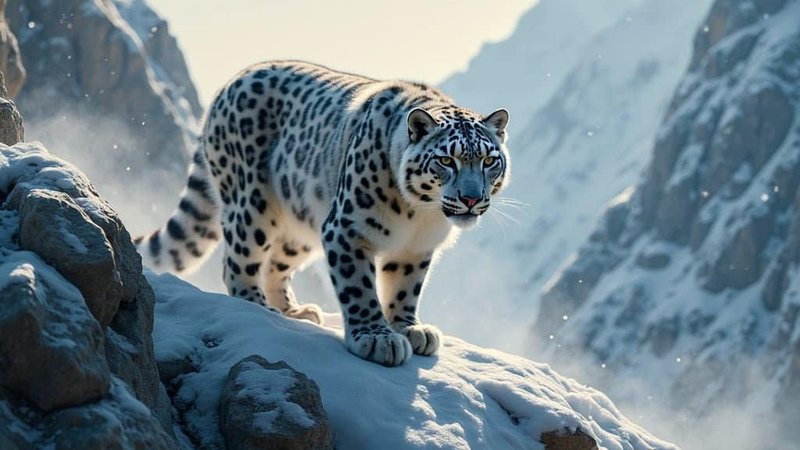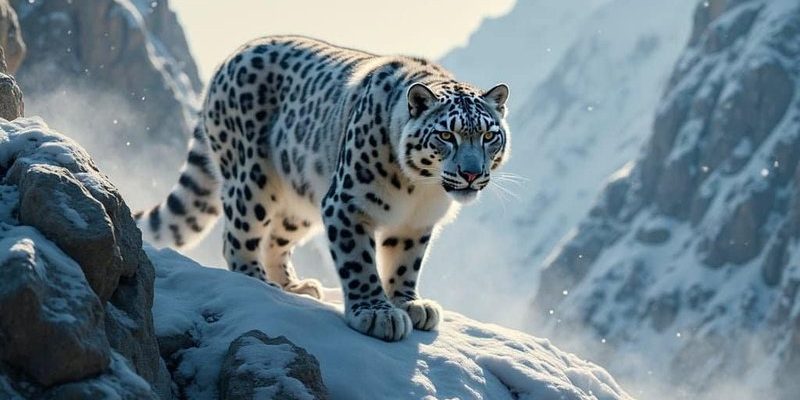
Imagine sitting in a cozy café, sipping on your favorite drink, as we explore how this majestic animal has woven its way into the fabric of different societies. From ancient stories passed down through generations to modern art celebrating their beauty, the snow leopard stands as a powerful emblem. Let’s dive into the captivating ways this enchanting feline is represented around the world.
Snow Leopard Symbolism in Asian Cultures
In many parts of Asia, particularly in regions where snow leopards roam, these creatures are often respected as sacred beings. For instance, in Tibetan culture, the snow leopard is revered not just for its strength but also for its role as a guardian spirit. You might find intricate carvings and paintings of these animals in monasteries and temples, symbolizing protection and spiritual power.
In folklore, there’s a belief that the snow leopard has the ability to connect the physical and spiritual realms. Stories often depict them as messengers from the heavens, carrying messages from the gods. Isn’t it fascinating to think of an animal bridging our world and the divine? This connection inspires not only awe but also reverence, prompting local communities to protect their habitats and ensure their survival.
Moreover, snow leopards are sometimes seen as symbols of independence and agility. In many tales, they embody qualities like self-reliance and the ability to thrive in harsh conditions—a reflection of the tough lives many local people lead in the challenging terrains of the Himalayas.
Folktales and Legends Featuring Snow Leopards
Snow leopards have found their way into numerous folktales, often woven into narratives that teach important life lessons. One popular legend tells of a snow leopard who befriends a humble mountain goat. Together, they navigate the dangers of the mountain, illustrating themes of friendship and cooperation.
What’s interesting is how these tales often highlight the balance between predator and prey. The snow leopard is not just a powerful hunter but also a crucial part of the ecosystem. In this way, they represent both the beauty and brutality of nature, reminding us of the interconnectedness of life.
Additionally, some folktales depict the snow leopard as a guardian of the mountains, where it ensures harmony among the animals. These legends serve to instill a sense of respect for wildlife and the intricate balance that nature maintains. How cool is it to think that such stories can energize communities to cherish and protect their natural surroundings?
Contemporary Art and Literature Inspired by Snow Leopards
Fast forward to today, snow leopards continue to inspire artists, writers, and filmmakers worldwide. Their striking beauty and elusive nature make them perfect subjects for creative expressions. Artists capture them in paintings, sculptures, and photography, often highlighting their natural habitat and the challenges they face due to climate change and habitat loss.
You might notice that in contemporary literature, snow leopards serve as metaphors for resilience and beauty in the face of adversity. Authors often use these magnificent cats to represent characters who embody these qualities, creating relatable and inspiring narratives.
These artistic interpretations help raise awareness about the importance of conservation. By featuring snow leopards in art and literature, creators encourage viewers and readers to engage with environmental issues. It’s amazing how something as simple as a painting or a story can spark meaningful conversations about wildlife protection!
Snow Leopards in Indigenous Beliefs
Indigenous peoples living in the regions inhabited by snow leopards often have unique beliefs surrounding these animals. For example, many view the snow leopard as a protector of the mountains, a symbol of strength and endurance. Traditional practices may include rituals or ceremonies to honor the snow leopard and express gratitude for its presence in the ecosystem.
In these cultures, the snow leopard is often associated with important natural elements, like snow and ice. As you can imagine, this connection creates a deep bond between the people and the land, reinforcing the need for conservation. Stories passed down through generations ensure that these beliefs endure, keeping the spirit of the snow leopard alive.
Honestly, it’s remarkable how the snow leopard embodies both cultural significance and ecological responsibility. As custodians of the land, those who hold these beliefs often take active roles in protecting their environment, ensuring that future generations can experience the magic of the snow leopard.
The Snow Leopard as a Conservation Icon
In recent years, the snow leopard has become a symbol in the fight for wildlife conservation. Organizations dedicated to protecting endangered species often use the snow leopard as their emblem. These big cats represent the challenges of conservation due to their elusive nature and the threats they face from habitat destruction and poaching.
Using the snow leopard in campaigns helps raise awareness about broader environmental issues affecting not only these big cats but also various species sharing their habitat. It’s a poignant reminder of the fragility of ecosystems and the interconnectedness of all living beings. You might be wondering how you can help—simple actions like supporting conservation projects or spreading awareness can make a big difference.
The efforts to protect snow leopards also serve as a beacon of hope. By rallying communities and raising funds, groups are working hard to preserve not just the snow leopards but also the breathtaking landscapes they inhabit. Seeing these efforts gain traction is truly inspiring and shows that every small step counts in the journey towards conservation.
Snow Leopard Representation in Modern Media
You might be surprised to learn that snow leopards have also made their mark in modern media. Documentaries, films, and television shows often feature these elusive felines, showcasing their beauty and the challenges they face. This exposure helps educate people about their plight and fosters a connection between viewers and wildlife.
Nature documentaries, for instance, provide a front-row seat to the life of snow leopards in their natural habitat. Watching them leap gracefully across rocky terrains offers a sense of wonder and admiration. You might even feel inspired to take action after learning more about their struggles and the ongoing efforts to protect them.
Additionally, video games and animated films occasionally draw on the imagery of the snow leopard, allowing younger audiences to engage with these creatures in a fun, interactive way. This modern representation helps keep conversations about conservation alive, making it accessible to a broader audience. Isn’t it fantastic how these majestic cats can inspire us across different platforms and generations?
The Future of Snow Leopard Representation
As we move forward, the representation of snow leopards in culture and folklore will likely continue to evolve. With the increasing awareness of climate change and wildlife conservation, these creatures may take on even greater significance as symbols of resilience and survival.
Engaging storytelling, art, and media will play vital roles in shaping how future generations perceive snow leopards. By continuing to highlight their importance in various cultures, we can preserve their legacy and inspire actions that lead to their conservation.
Ultimately, the story of the snow leopard is one of beauty, strength, and the pressing need for protection. It’s a reminder that every creature plays a role in the rich tapestry of our world. So, let’s cherish these remarkable animals and ensure their legacy continues for generations to come.
In conclusion, the snow leopard is much more than a mysterious mountain feline—it’s a powerful symbol woven into the cultural fabric of various societies. From ancient folklore to contemporary art, its representations resonate deeply, reminding us of our connection to nature and the responsibility we hold in protecting it. If we continue to honor and celebrate these magnificent cats, we can create a brighter future for them and the ecosystems they inhabit.

